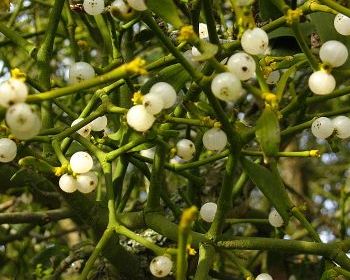- Series:Plants, Transcript English
Genesis 1:11
“And God said, Let the earth bring forth grass, the herb yielding seed, [and] the fruit tree yielding fruit after his kind, whose seed [is] in itself, upon the earth: and it was so.”
When God designed the mistletoe, He brought the design of the plant and the feeding habits of birds together into a wonderfully designed working system. Then He made one amazing exception to the design.
While the wild mistletoe has chlorophyll so that it is able to make some of its own food, it is a parasite that  also receives much of its nourishment from the tree on which it grows. The seeds of the mistletoe must sprout into the living tissue of a tree.
also receives much of its nourishment from the tree on which it grows. The seeds of the mistletoe must sprout into the living tissue of a tree.
Mistletoe blooms in early winter, producing a white berry. These berries contain seeds as well as a very sticky pulp which birds find quite tasty. Many of the seeds are thus spread through the birds’ droppings. Some seeds, covered in the sticky pulp, end up on the outside of the birds’ beaks. We have all seen how birds will clean their beaks by rubbing them on a tree branch. If they have been eating mistletoe berries, their beak cleaning glues the mistletoe seeds to a perfect spot for them to grow.
The dwarf mistletoe is the one exception to this system. When its seeds are ripe, the berries explode, shooting seeds to neighboring branches up to 40 feet away.
Whether we look at how God has brought different creatures together for their mutual benefit, or see the creative means He has designed so they can reproduce, we must exclaim, “Truly the Lord has done all things well!”
Prayer:
Father, every part of the creation shows forth Your glory. I pray that You would open people’s minds so they may see Your glorious works and join Your people in praising You now and forever. In Jesus’ Name. Amen.
Notes:
Photo: Mistletoe berries.
